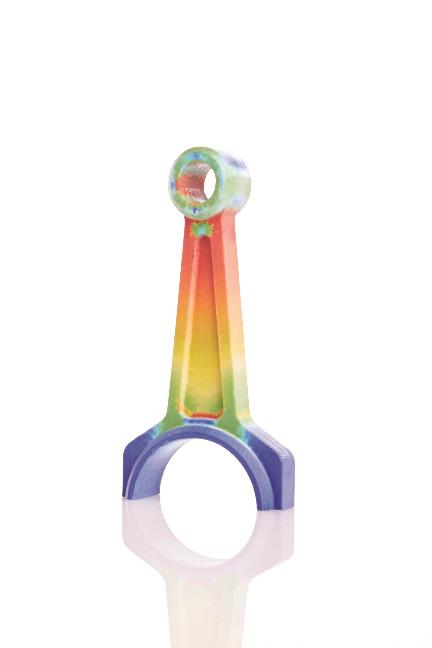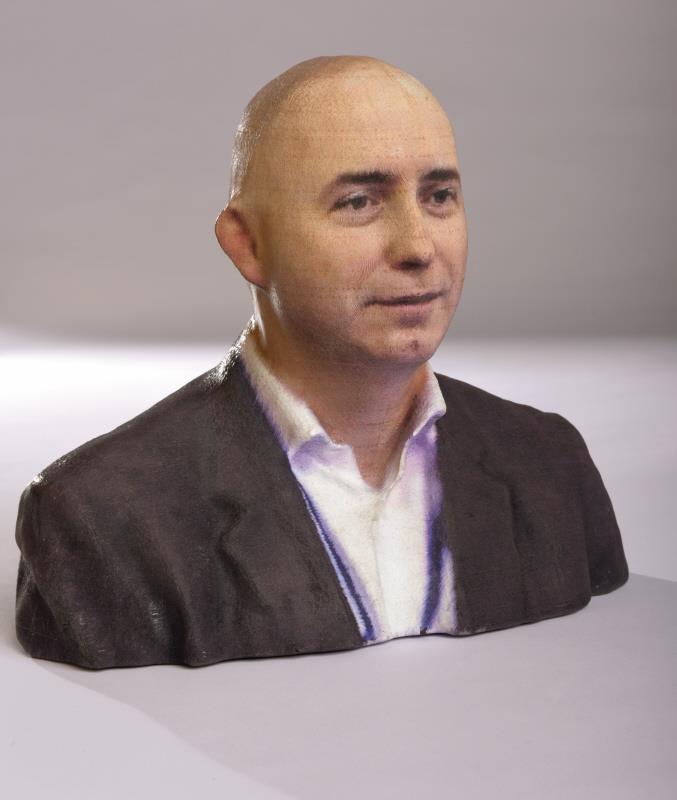Opening a bottle of Coke with a bottle opener made on Mcor’s IRIS HD printer immediately dispels the over-riding negative assumption that people would have about products made on the platform. They are solid. So solid in fact that you could print a hammer and use it to go about its nail-hammering business. The reason this is surprising is that both hammer and bottle opener are made of paper, as are all the products made on the machine.
“There's a bit of snobbery in the trade of printing,” claimed Dr Conor MacCormack, CEO of Mcor. “I showed a part [at a conference] and we talked about the colour and people were very impressed, blown away in fact.At the end I said, well, what do you think it's made of? Nobody gets it right. Undoubtedly there is a bit of a negative connotation with paper, that's why one of our challenges is to get parts into people's hands.”
Paper is porous, in fact it is around 70%. If different properties are required the model can therefore dipped in a resin or other liquid and when it cures it will take on the properties of that liquid. “There's lots of opportunities,” claimed MacCormack. “If you want it waterproof, you can make it waterproof.If you want it really hard, you can make it hard.If you want it flexible, you can have flexible parts. It is all paper but there's a lot more use cases to it than people initially imagine.”
This opens the door for unlimited prototyping solutions, but also for more functional applications. While possibly paper-based parts will still in some cases be unsuitable as actual end-use components, they may be useful for other purposes, like tooling and jigs.
And paper, of course, is cheap. The feedstock can be the same block of 80GSM paper that is used in a standard office printer. Even taking into adhesives and inks, Mcor claims that typical material costs are in the region of 10 – 20% those of other 3D printing technologies. According to MacCormack, the cost advantages of the IRIS system – Mcor’s 3D printing platform – is one its two main ‘USPs’. The other one is colour.
The problem most people have with printing in colour is that it requires blending materials that are primary colours. While all colours can be arrived at it is a slow and inaccurate process. MacCormack said: “If you type ‘full colour 3D printing’ into Google you will get loads of people who say they can do it, but actually it is impossible for them. There's only two companies that can colour print properly, and both are kind of based on the jetting ink. One jet adds the powder and binds the powder together [3D Systems], and then we jet ink on the paper.That's how we get a higher resolution, because we're printing on the paper, and that's what ink was developed for.”
Selective Deposition Lamination (SDL) is how Mcor label the technology. In simplistic terms the way it works by feeding through sheets of paper one at a time. Each sheet is cut out using the tungsten carbide blade to a depth of 150um – as each sheet is typically 100um then it will only cut through the uppermost sheet. The ink which penetrates the paper is jetted within the adhesive, which is put down in high concentrations on the areas that are to form the model and only minimal amounts on the waste. This way the waste material very easily can be crumbled away just using fingertips.
Ink is jetted out to the cut border, i.e. what will become the visible surface. The improved algorithms in the latest versions have not only increased colour resolution, they have also allowed this coloured border to be made thinner, hence the saving in ink costs. Over a million different colours can be used.

Mcor’s SliceIT control software for its 3D printers reads the digital data and slices the computer model into printable layers equivalent in thickness to the paper. The software also enables the user to position the model, or several models, within the 3D printer’s build chamber. It will also take in any colour information from the source files. “For example, in SolidWorks if you did an FEA analysis and you look at stress,” said MacCormack, “you just right click your stress plot, then save that as a VRML file and read that straight into SliceIT.All the geometry and the colour are brought in, so the model will show the stresses.” [Left]
Additive manufacturing, for all its hype is still an untapped resource in some parts of the market according to MacCormack. “I think creative people want something that you press a button and it runs. They want high quality to match their expectation level and I think that's the reason why they haven't got into it as much. Creativity is what's important to a designer.And I think sometimes when they look at what comes out of a desktop 3D printer, they go ‘it's awful’. So I think personally that there is a disconnect between creative people and what the output is.”
Mcor believes that its technology, particularly now that it has been enhanced by the software algorithms to improve colour print sharpness and new cutting blade to improve resolution, can overcome these disappointing outputs, without the high expense of the high end machines.
“The advantage of having a 3D printer with true colour representation is that you can print anything you scan,” claimed Conor MacCormack. The new IRIS HD 3D printer features photorealistic 5760 x 1440 x 508 dpi bitmap colour. All you need is a 3D scanner with similar colour capture capabilities and resolution. Physical resolution for the x, y and z axis is 12u, 12u and 100u respectively. |
IRIS HD Earlier this year the company introduced the IRIS HD that offers sharpened details and a further 20% reduction in operating costs. Built on new algorithms and a newly designed carbide cutting tip, the IRIS HD makes full-colour detail and text on 3D printed models crisper to deliver a photorealistic appearance around the full geometry of the model and better communication of granular information. The cost reductions come from the increased life of the cutting tip and the reduced cost of ink. Dr. Conor MacCormack claimed: “Our SDL [Selective Deposition Lamination] paper-based 3D printing technology has always offered the industry’s highest-resolution colour at the lowest operating costs.Now, with IRIS HD, we’re providing even greater access to truly photorealistic colour 3D printing.” |








 The 3D selfie
The 3D selfie 


